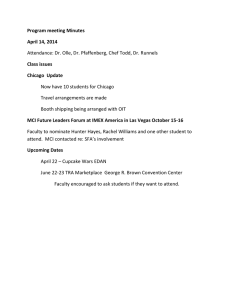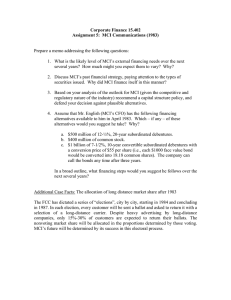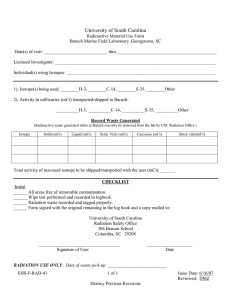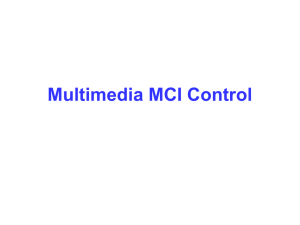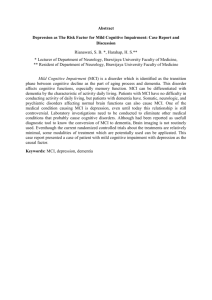Neuropsychology Self-Referencing and False Memory in Mild Cognitive
advertisement
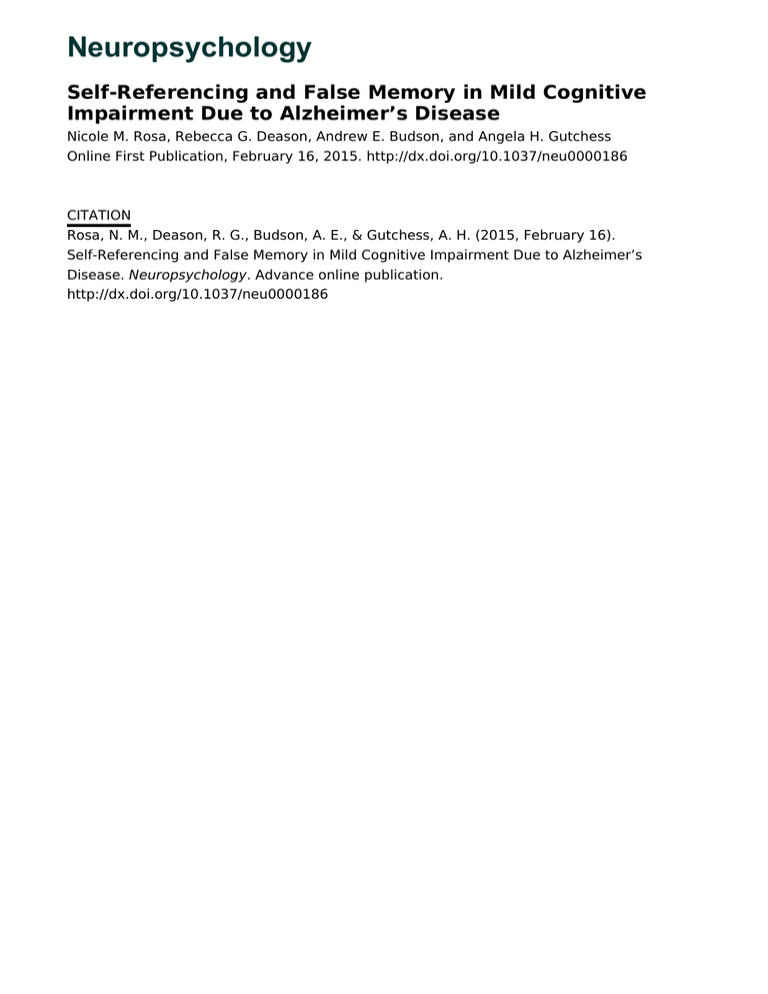
Neuropsychology Self-Referencing and False Memory in Mild Cognitive Impairment Due to Alzheimer’s Disease Nicole M. Rosa, Rebecca G. Deason, Andrew E. Budson, and Angela H. Gutchess Online First Publication, February 16, 2015. http://dx.doi.org/10.1037/neu0000186 CITATION Rosa, N. M., Deason, R. G., Budson, A. E., & Gutchess, A. H. (2015, February 16). Self-Referencing and False Memory in Mild Cognitive Impairment Due to Alzheimer’s Disease. Neuropsychology. Advance online publication. http://dx.doi.org/10.1037/neu0000186 Neuropsychology 2015, Vol. 29, No. 2, 000 © 2015 American Psychological Association 0894-4105/15/$12.00 http://dx.doi.org/10.1037/neu0000186 This document is copyrighted by the American Psychological Association or one of its allied publishers. This article is intended solely for the personal use of the individual user and is not to be disseminated broadly. Self-Referencing and False Memory in Mild Cognitive Impairment Due to Alzheimer’s Disease Nicole M. Rosa Rebecca G. Deason Brandeis University and Worcester State University Boston University School of Medicine, VA Boston Healthcare System, Boston, Massachusetts, and Texas State University Andrew E. Budson Angela H. Gutchess Boston University School of Medicine and VA Boston Healthcare System, Boston, Massachusetts Brandeis University Objective: The present study explored the role of self-referencing on false alarm rates among people with mild cognitive impairment suggestive of the early signs of the Alzheimer’s disease pathophysiologic process (MCI–AD). Given that people with MCI–AD demonstrate higher rates of false alarms and that false alarms have been shown to increase for self-relevant information, it was predicted that people with MCI–AD would experience a disproportionate increase in memory errors for highly self-related information. Method: Patients with a diagnosis of MCI–AD (n ⫽ 23) and healthy control participants (n ⫽ 27) rated words for self-descriptiveness or commonness and completed a surprise recognition test. Results: Contrary to expectations, results indicated that people with MCI–AD were at no greater risk for false alarms than were control participants as a function of self-descriptiveness, relative to a control condition. Despite the MCI–ADs’ greater bias to say “yes” in the self condition, increasing self-descriptiveness did not lead to higher false alarm rates and did not impair performance in the self condition relative to commonness judgments. Conclusions: Therefore, although people with MCI–AD may be more susceptible to memory errors, they are at no greater risk of self-related errors than healthy control participants. Keywords: MCI–AD, self-reference, false memory, response bias decline in episodic memory is considered to be the hallmark sign of AD (Salmon, Butters, & Chan, 1999). Although recent work has shown that self-reference is one memory tool that may assist people with memory impairment (Kalenzaga, Bugaiska, & Clarys, 2012; Kalenzaga & Clarys, 2013; Rosa, Deason, Budson, & Gutchess, 2014), in certain circumstances it is possible the same mechanisms that contribute to accurate memory may increase the risk of error. Self-reference aids memory by connecting new information to the self (Symons & Johnson, 1997) allowing for deeper processing (Craik & Lockhart, 1972) and better organization of information (Klein & Kihlstrom, 1986). As a result, self-reference offers a spontaneous and efficient (Rogers, Kuiper, & Kirker, 1977; Yang, Truong, Fuss & Bislimovic, 2012) benefit to memory that may be different from other memory strategies. This benefit appears to persist in AD. Recent work by Kalenzaga and colleagues 2012, 2013 using a Remember/Know/ Guess paradigm demonstrated that for participants with Alzheimer’s disease, a self-reference condition increased the number of “remember” responses compared with that of a control condition, even though this group had fewer “remember” responses overall, compared with control participants (Kalenzaga et al., 2012; Kalenzaga & Clarys, 2013). In our previous work, we have also found that self-referencing affects memory among people with MCI–AD with a benefit in item memory and a reduction in self-related source errors (Rosa et al., 2014). On the basis of these previous studies, it appears as though self-reference does continue to provide a benefit to accurate memory in people with MCI–AD despite losses associated with the disease. As we age, memory becomes more prone to errors and distortions. This is particularly true for people with mild cognitive impairment suggestive of the early signs of the Alzheimer’s disease pathophysiologic process (MCI–AD; Budson & Solomon, 2012). Whereas episodic memory typically suffers greater loss than other types of memory in normal aging (Old & Naveh-Benjamin, 2008), disproportionate Nicole M. Rosa, Psychology Departments, Brandeis University and Worcester State University; Rebecca G. Deason, Boston University School of Medicine, VA Boston Healthcare System, Boston, Massachusetts, and Department of Psychology, Texas State University; Andrew E. Budson, Boston University School of Medicine and VA Boston Healthcare System, Boston, Massachusetts; Angela H. Gutchess, Psychology Department, Brandeis University. This research was supported by National Institute on Aging grants R01 AG025815 (AEB) and P30 AG13846 (AEB), by Department of Veterans Affairs, Veterans Health Administration, VISN 1 Early Career Development Award (RGD), and by the Psychology Department at Brandeis University (NMR). This material is also the result of work supported with resources and the use of facilities at the VA Boston Healthcare System. The authors thank Peter Millar and Sean Flannery for their research assistance, and acknowledge the helpful comments and suggestions of Dr. Leslie Zebrowitz, Dr. Joseph Cunningham, and Dr. Alice Cronin-Golomb. Correspondence concerning this article should be addressed to Nicole M. Rosa, Department of Psychology, Worcester State University, 486 Chandler Street, Worcester, MA 01602. E-mail: nrosa@comcast.net 1 ROSA, DEASON, BUDSON, AND GUTCHESS This document is copyrighted by the American Psychological Association or one of its allied publishers. This article is intended solely for the personal use of the individual user and is not to be disseminated broadly. 2 The same mechanisms that allow us to receive a benefit from self-reference may, however, also contribute to self-related false memory. As we age, accurate recall decreases while false memory, remembering an event that never happened or misremembering the details of an event, increases and this pattern is even stronger in MCI–AD (Balota et al., 1999). Given this increased risk of false memory, the deeper processing believed to play a role in selfreference may trigger an increase in associations and increase false memory, particularly in MCI–AD. Self-reference may also increase false memory because the self is well known and information connected to the self may be processed more fluently. Although this is typically seen as a mechanism that facilitates the use of the self in memory (Symons & Johnson, 1997), increased fluency of processing may contribute to false memory (Rogers, Rogers, & Kuiper, 1979), particularly with age (Rosa & Gutchess, 2013). When information is fluently processed due to selfrelevance, it is likely to create a sense of familiarity or feelings of having been previously encountered (Jacoby & Whitehouse, 1989), and these feelings of familiarity may serve to increase the intrusions that lead to false memory (Gallo, Cotel, Moore, & Schacter, 2007). Familiarity could also lead to an increase in false memory in recognition if there is a sense of experience with a word or object and there is not a more recognizable option. Although familiarity may contribute to false memory in healthy older adults (Gallo, Cotel, et al., 2007), people with MCI–AD are less able to utilize recollection to oppose familiarity (Pierce, Sullivan, Schacter, & Budson, 2005). People with MCI–AD demonstrate a more liberal response bias, a greater tendency to respond “old” on a memory test (Balota, Burgess, Cortese & Adams, 2002), and familiarity may increase this bias (Deason, Hussey, Ally, & Budson, 2012). Therefore familiarity may lead people to say new information is old and likely poses an increased risk of false memory in those with MCI–AD (Budson, Daffner, Desikan & Schacter, 2000). The present study expands on previous work by exploring the role of self-reference on false memory among people with cognitive impairment due to MCI–AD. Previous research (Rogers et al., 1979; Rosa & Gutchess, 2013) has shown an increase in false memories as information is more self-descriptive, however this effect has not been tested in people with cognitive impairment. Self-reference may increase the familiarity of information in such a way that the fluency, or ease of access, of the information increases as well (Jacoby & Whitehouse, 1989). This increase in familiarity and fluency may lead participants to believe new self-related information is old and result in increased false alarms. While older adults are already at risk for increased false memory (Schacter, Koutstaal, & Norman, 1997), older adults with MCI–AD are even more vulnerable (Balota et al., 1999; Gallo et al., 2006). Therefore, we expected that the increase in false alarms as a result of self-reference would be even greater for MCI–ADs than control participants. Method Participants Twenty-three participants (12 men, 11 women) with a clinical diagnosis of MCI–AD pathophysiologic process (Albert et al., 2011) and 27 (11 men, 16 women) healthy older adults are in- cluded in all analyses. Participation took place in the participant’s home or at Brandeis University. As shown in Table 1, MCI–ADs performed worse than control participants on all tests of cognitive functioning (Adjutant General’s Office, 1944; Folstein, Folstein, & McHugh, 1975; Mack, Freed, Williams, & Henderson, 1992; Monsch et al., 1992; Morris et al., 1989). Materials Two lists were created using a list of adjectives rated for likability (Anderson, 1968). An equal number of positive and negative words were selected from the extreme ends of the ratings to create two lists (old and new) of 120 words each and were equated for likability. Words contained an average of 9.15 letters and the mean frequency score was 17.04 (Kúcera & Francis, 1967). Procedure Participants rated 60 adjectives for self-descriptiveness (“I am”) and 60 adjectives for commonness (“How commonly is the word used”) on a 6-point scale (1 ⫽ this word never describes me/this word is never used; 6 ⫽ this word always describes me/this word is always used) either verbally with a key press made by the experimenter (MCI–ADs) or with a key press (control participants). Adjectives were presented for 6 s, followed by a blank screen for 1 s. Conditions alternated, with blocks of 7 to 8 words per reference condition. A fixation cross appeared between each block to indicate a change in condition. Following a retention interval, participants completed a surprise, self-paced recognition test comprising the previously seen 120 words as well as 120 new lures. Participants indicated either verbally (MCI–ADs) or using a key press (control participants) whether each word was “old” or “new” to denote whether the word was seen during the encoding. Finally, participants rated the 120 new lure words for selfdescriptiveness using the same scale used at encoding. Table 1 Demographics by Group Control Patient Characteristic/Instrument M SD M SD Age Education Shipley (of 40)ⴱ MMSE (of 30)ⴱ CERAD Immediate (of 30)ⴱ Delayed (of 10)ⴱ Recognition (of 10)ⴱ Word fluency FASⴱ CATⴱ Boston naming (of 15)ⴱ Trails Aⴱ Trails Bⴱ 75.63 15.39 36.48 28.89 6.56 3.04 3.16 1.53 78.65 14.04 31.73 24.91 5.01 2.84 6.47 3.32 16.35 5.77 9.69 3.50 1.63 .62 13.14 2.75 7.95 3.34 1.52 1.54 49.50 44.96 14.35 35.52 88.35 13.96 9.79 1.09 10.12 53.36 37.19 32.67 11.76 61.35 154.21 11.43 11.69 3.13 40.26 84.14 Note. MMSE ⫽ Mini Mental Status Exam; CERAD ⫽ Consortium to establish a registry for Alzheimer’s disease. ⴱ p ⬍ .01. FALSE MEMORY AND MCI–AD Results Scoring To minimize missing data in the event that some participants did not use all values on the scale, ratings were collapsed (1–2 ⫽ “low,” 3– 4 ⫽ “middle,” 5– 6 ⫽ “high”). See Table 2 for proportion of items in each category.1 Hits This document is copyrighted by the American Psychological Association or one of its allied publishers. This article is intended solely for the personal use of the individual user and is not to be disseminated broadly. Hit rates were calculated as a proportion of correctly recognized old items within each reference condition at each rating level. Table 2 Proportion of Hits, False Alarms, Corrected Recognition, and Response Bias in Each Condition Control M Item/Category Self Low Middle High Common Low Middle High Hits Self Low Middle High Common Low Middle High False alarms Self Low Middle High Common Low Middle High Corrected recognition Self Low Middle High Common Low Middle High Response bias Self Low Middle High Common Low Middle High MCI–AD (SD) M (SD) .37 .29 .33 (.11) (.15) (.13) .29 .34 .25 (.11) (.18) (.12) .17 .33 .49 (.14) (.18) (.25) .16 .36 .32 (.15) (.23) (.27) 0.67 0.72 0.81 (0.14) (0.15) (0.14) 0.62 0.65 0.74 (0.19) (0.18) (0.23) 0.64 0.59 0.69 (0.28) (0.22) (0.21) 0.60 0.62 0.75 (0.28) (0.28) (0.21) 0.25 0.25 0.46 (0.15) (0.20) (0.19) 0.41 0.47 0.64 (0.23) (0.22) (0.20) 0.32 0.27 0.37 (0.27) (0.16) (0.23) 0.35 0.46 0.57 (0.27) (0.21) (0.19) 0.43 0.48 0.37 (0.14) (0.25) (0.19) 0.25 0.20 0.09 (0.17) (0.17) (0.21) 0.28 0.31 0.29 (0.30) (0.26) (0.21) 0.17 0.19 0.22 (0.25) (0.18) (0.17) 0.10 0.10 ⫺0.55 (0.42) (0.44) (0.51) ⫺0.03 ⫺0.23 ⫺0.89 (0.67) (0.71) (1.00) 0.16 0.23 ⫺0.12 (0.98) (0.42) (0.84) 0.13 ⫺0.28 ⫺0.69 (1.09) (0.83) (0.82) 3 Using a factorial analysis of variance (ANOVA) with group as the between-subjects variable and reference (self/common) and rating (low/middle/high) as within subject variables, there was a main effect of reference, F(1, 40) ⫽ 4.95, p ⫽ .03, p2 ⫽ .11, with self (M ⫽ .70, SD ⫽ .15, 95% CI [.66, .75]) related words leading to higher hit rates than words rated for commonness (M ⫽ .65, SD ⫽ .22, 95% CI [.58, .71]). There was also a main effect of rating, F(2, 98) ⫽ 16.56, p ⬍ .001, p2 ⫽ .29. As shown in Table 2, words in the high rating level led to higher hit rates (M ⫽ .75, SD ⫽ .18, 95% CI [.69, .80]) than those in the low (M ⫽ .63, SD ⫽ .20, 95% CI [.58, .69]), F(1, 40) ⫽ 22.59, p ⬍ .001, p2 ⫽ .36, and middle rating levels (M ⫽ .65, SD ⫽ .19, 95% CI [.59, .70]), F(1, 40) ⫽ 24.10, p ⬍ .001, p2 ⫽ .38. There was no significant difference between the low and middle levels (p ⬎ .10). There were no significant interactions involving rating (ps ⬎ .10). There was no main effect of group and no interaction involving group (ps ⬎ .10). On the basis of previous work in which healthy older adults demonstrated a higher hit rate in the self condition relative to common (Rosa & Gutchess, 2013), we ran separate analyses for each group to determine if the previous pattern could be replicated. As shown previously, control participants exhibited a main effect of reference, F(1, 23) ⫽ 7.28, p ⫽ .01, p2 ⫽ .24, such that self led to higher hit rates (M ⫽ .74, SD ⫽ .01, 95% CI [.69, .78]) than common (M ⫽ .64, SD ⫽ .01, 95% CI [.56, .73]), but the same was not true for MCI–AD patients even when differences in cognitive ability were controlled for using Mini-Mental State Examination (MMSE) as a covariate (p ⬎ .10). Although the patients also did not show a main effect of rating when controlling for MMSE (p ⬎ .10), there was also a main effect of rating among control participants, F(2, 46) ⫽ 6.31, p ⫽ .004, p2 ⫽ .22, with words in the high rating leading to more hits (M ⫽ .75, SD ⫽ .14, 95% CI [.69, .80]) than those in the low (M ⫽ .66, SD ⫽ .20, 95% CI [.58, .74]) or middle ratings (M ⫽ .66, SD ⫽ .16, 95% CI [.60, .72]). There were no interactions for either group (ps ⬎ .10). False Alarms Note. MCI–AD ⫽ Mild cognitive impairment suggestive of the early signs of the Alzheimer’s disease pathophysiologic process. We hypothesized that false alarms would increase along with self-descriptiveness, particularly for MCI–AD patients. To test this, false alarms were calculated as the proportion of new items incorrectly called “old” within each condition at each rating level. A factorial ANOVA with group as the between-subjects variable 1 We also examined the distribution of ratings across the groups to evaluate whether patients and control participants differed in their ratings. Focusing on differences between the two groups, there was a main effect of group, F(1, 48) ⫽ 20.44, p ⬍ .001, 2p ⫽ .11, with control participants rating more words in the high category (M ⫽ .33, SD ⫽ .04) than patients (M ⫽ .29, SD ⫽ .04). There was a significant interaction between condition and group, F(1, 48) ⫽ 9.48, p ⫽ .003, 2p ⫽ .17, with control participants rating words in both conditions in a similar manner (self: M ⫽ .33, SD ⫽ .04 vs. common: M ⫽ .33, SD ⫽ .05) whereas patients rated more words as high in the self condition (M ⫽ .29, SD ⫽ .04) than in the common condition (M ⫽ .28, SD ⫽ .05). There was also a marginal interaction between rating and status F(1, 96) ⫽ 2.84, p ⫽ .06, 2p ⫽ .06. It appears as though control participants rated more words in the high-rating level (M ⫽ .41, SD ⫽ .23), whereas patients used the middle category more (M ⫽ .35, SD ⫽ .23). There was no interaction among group, condition, and rating, p ⬎ .10. Despite these slight differences in patterns, both groups distributed their responses rather evenly across the high, medium, and low levels, which allows us to compare memory performance for patients and control participants using these bins of items. This document is copyrighted by the American Psychological Association or one of its allied publishers. This article is intended solely for the personal use of the individual user and is not to be disseminated broadly. 4 ROSA, DEASON, BUDSON, AND GUTCHESS and reference (self/common) and rating (low/middle/high) as the within-subject variables indicated a main effect of group, F(1, 32) ⫽ 10.79, p ⫽ .002, p2 ⫽ .25, with MCI–AD patients exhibiting higher false alarm rates (M ⫽ .48, SD ⫽ .25, 95% CI [.41, .55]) than control participants (M ⫽ .30, SD ⫽ .23, 95% CI [.24, .39]) as predicted (see Table 2). There was also the predicted main effect of rating, F(2, 64) ⫽ 20.18, p ⬍ .001, p2 ⫽ .39, with words in the high rating level leading to more false alarms (M ⫽ .51, SD ⫽ .22, 95% CI [.44, .58]) than words in the low (M ⫽ .33, SD ⫽ .20, 95% CI [27, .39]) or middle rating levels (M ⫽ .36, SD ⫽ .20, 95% CI [.30, .42]). Specific comparisons indicate that the high rating level was significantly different from the low, F(1, 32) ⫽ 25.82, p ⬍ .001, p2 ⫽ .45, and middle levels, F(1, 32) ⫽ 47.19, p ⬍ .001, p2 ⫽ .60, but there was no significant difference between the low and middle levels (p ⬎ .10). Despite the hypothesis that self reference would lead to higher false alarm rates than the common condition for words rated as highly self-relevant, especially for MCI–AD patients, there was no main effect of reference and there were no significant interactions (ps ⬎ .10). We again used MMSE as a covariate for patients and looked at each group separately to assess convergence with prior studies. For both control participants, F(2, 30) ⫽ 9.02, p ⫽ .001, p2 ⫽ .38, and patients, F(2, 20) ⫽ 3.47, p ⫽ .04, p2 ⫽ .19, there was a main effect of rating reflecting the same pattern described above. There was no main effect of reference and no interactions for either group (ps ⬎ .10). Corrected Recognition Corrected recognition scores were calculated by subtracting the proportion of false alarms from the proportion of hits for each rating level, to test whether there was a difference in memory accuracy across conditions as an effect of self-reference. It was expected that increases in false alarms would diminish overall memory performance as rating increased, particularly in the self condition relative to common. To test this, a factorial ANOVA with group as the between subject variable and reference (self/ common) and rating (low/middle/high) as the within-subject variables indicated a main effect of group with control participants demonstrating better memory (M ⫽ .36, SD ⫽ .20, 95% CI [.31, .42]) than MCI–AD patients (M ⫽ .19, SD ⫽ .24, 95% CI [.13, .24]), F(1, 29) ⫽ 20.28, p ⬍ .001, p2 ⫽ .41. There was a significant interaction between group and condition, F(1, 29) ⫽ 4.62, p ⫽ .04, p2 ⫽ .14, that is driven by the differences between the self and common conditions for the control participants. When the two groups are analyzed separately, as seen in Figure 1, control participants exhibited a main effect of reference, F(1, 15) ⫽ 5.57, p ⫽ .03, p2 ⫽ .27, such that self led to better memory (M ⫽ .43, SD ⫽ .20, 95% CI [.35, .51]) than common (M ⫽ .29, SD ⫽ .23, 95% CI [.20, .39]), but the same was not true for MCI–AD patients even when differences in cognitive ability were controlled for using MMSE as a covariate (p ⬎ .10). Neither group showed a main effect rating or any interactions when looking at control participants and when controlling for MMSE among patients (ps ⬎ .10). Last, although there was no main effect of rating (p ⬎ .10), there was a marginal interaction between rating and reference, F(2, 58) ⫽ 2.57, p ⫽ .09, p2 ⫽ .08. This interaction appears to be driven by differences within the self condition. As shown in Table 2, in the common condition, performance is relatively flat across Figure 1. Panel 1A: Pattern of corrected recognition showing the different pattern between reference and group with control participants demonstrating better memory for the self condition than for the common condition, whereas MCI–AD performance is relatively flat across both conditions. Panel 1B: Pattern of response bias showing differences between MCI–ADs and control participants at the middle and high rating levels. Error bars represent standard error. the three rating levels but in the self condition, as expected, memory for words in the low and middle rating levels was better than memory for words in the high rating. Looking just at the self condition, high significantly differs from the low, F(1, 29) ⫽ 6.21, p ⫽ .02, p2 ⫽ .1, 95% CI [.02, .20]) and middle rating conditions, F(1, 29) ⫽ 9.73, p ⫽ .004, p2 ⫽ .25, 95% CI [.04, .18], although there is no difference between the low and middle rating conditions (p ⬎ .10). In the common condition, there are no significant differences between any of the rating levels (ps ⬎ .10). Response Bias On the basis of previous work demonstrating that response bias can influence memory performance, particularly for MCI–AD patients (Deason, Hussey, Ally, & Budson, 2012), c values were calculated to test for differences between MCI–AD patients and control participants. Negative c values indicate a bias to say “yes,” whereas positive values indicate a “no” bias. A factorial ANOVA with group as the between-subject variable and reference condition (self/common) and rating (low/middle/high) as the within-subject variable indicated a main effect of reference, F(1, 30) ⫽ 3.21, p ⫽ .08, p2 ⫽ .10, such that though there was an overall bias to say “yes” in both conditions, this was more pronounced in the self This document is copyrighted by the American Psychological Association or one of its allied publishers. This article is intended solely for the personal use of the individual user and is not to be disseminated broadly. FALSE MEMORY AND MCI–AD condition (M ⫽ ⫺.25, SD ⫽ .67, 95% CI [⫺.46, ⫺.04]) than in the common condition (M ⫽ ⫺.09, SD ⫽ .83, 95% CI [⫺.34, .16]), as seen in Table 2. There was also a main effect of rating, F(2, 60) ⫽ 29.18, p ⬍ .001, p2 ⫽ .49, with a stronger bias to say “yes” in the middle (M ⫽ ⫺.05, SD ⫽ .67, 95% CI [⫺.25, .16]) and high (M ⫽ ⫺.56, SD ⫽ .90, 95% CI [⫺.84, ⫺.28]) rating levels but to respond “no” in the low rating level (M ⫽ .09, SD ⫽ .76, 95% CI [⫺.14, .32]). Although the main effect of group was not significant (p ⬍ .10), as shown in Figure 2, there was a marginal interaction between group and rating, F(2, 60) ⫽ 2.69, p ⫽ .08, p2 ⫽ .08, that appears to be driven by a marginal difference between the control participants and MCI–AD patients in the middle, F(1, 44) ⫽ 3.58, p ⫽ .07, p2 ⫽ .08, 95% CIs [⫺.09, .35] and [⫺.42, .06], respectively, and high, F(1, 42) ⫽ 3.88, p ⫽ .06, p2 ⫽ .09, 95% CIs [⫺.58, ⫺.02] and [⫺1.04, ⫺.40], respectively, rating levels. Again exploring the two groups separately, we see differences between the patient and control groups in response bias. When we use MMSE as a covariate to control for differences in cognitive ability in the patient group, we find a marginal effect of rating, F(2, 26) ⫽ 2.75, p ⫽ .09, p2 ⫽ .17, that mirrors the pattern described above and a marginal interaction between reference and rating, F(2, 26) ⫽ 3.04, p ⫽ .07, p2 ⫽ .19, that appears to be driven by a stronger “yes”; bias in the self condition, particularly at the low and high rating levels. There was no main effect of reference (p ⬎ .10). For control participants, there is a main effect of reference, F(1, 15) ⫽ 3.47, p ⫽ .08, p2 ⫽ .19, and a main effect of rating, F(2, 30) ⫽ 11.90, p ⬍ .001, p2 ⫽ .44, that follow the above pattern. There was no interaction between the two (p ⬎ .10). Discussion Unlike previous studies (Kalenzaga et al., 2012; Kalenzaga & Clarys, 2013), MCI–AD patients in the present study did not show a self-reference benefit for hits. In fact, hit rates appear similar in the self and common conditions. MCI–AD patients also do not exhibit an increase in hits across rating levels in the same way as control participants. In contrast, control participants show a selfreference benefit, with an increase in hits in the self condition relative to the common condition, as seen in previous work (Rosa & Gutchess, 2013). For false alarms, whereas MCI–AD patients commit more false alarms as predicted, we also expected that false alarms would be higher in the self condition but there was no difference between the self and common condition indicating that self-reference does not necessarily lead to an increase in false alarms. Therefore, MCI–AD patients, when compared with control participants, do not seem to be at a greater risk of false alarms for self-related information. For corrected recognition, the self-reference benefit to hits is maintained for control participants in the self condition when control participants are examined alone, with better memory performance in the self condition than in the common condition. Therefore, for control participants, self-reference potentially provides the expected benefit to memory through an increase in hit rates without an associated increase in overall false alarms. For MCI–AD patients, corrected recognition indicates that selfreference may not be benefitting memory, but it is also not hurting memory through an increase in false alarms. Given the lack of benefit to correct recognition, it is possible that MCI–AD patients are not using the self in memory in the same way as seen in control 5 participants. On the basis of previous work (Kalenzaga et al., 2012; Kalenzaga & Clarys, 2013; Rosa et al., 2014), it was initially hypothesized that self-referencing may build upon intact memory for self-relevant information such that MCI–AD patients would have better memory for self-related new information. However, self-reference may benefit people with MCI–AD in some situations more than others. In our previous work, we found that self-reference benefits people with MCI–AD in that they are less likely to falsely claim an item as being self-related (Rosa et al., 2014). In a Remember/Know/Guess paradigm, Kalenzaga and colleagues (2012, 2013) found a self-reference benefit with no significant differences between patients and control participants in correct “remember” responses but not for “know” responses. It is possible participants in the present study similarly felt more confident in their memory for some items than others and when these items are pooled together, the benefits seen in “remember” responses are diminished by performance in the “know” responses. Uncertainty in memory may lead to an increase in reliance on gist among people with MCI–AD. As shown in previous research, reliance on gist can hurt performance in people with Alzheimer’s disease (Budson et al., 2006; Gallo et al., 2006; Pierce et al., 2005). Cognitively impaired individuals may have been swayed by a general memory of having seen self-related information. Lacking specific memory of the information, they may have utilized gist and a feeling of familiarity to make their decision. However, for control participants, it is possible that reliance on gist helps to distinguish between old and new stimuli and contributes to accurate memory. Control participants may be better able to utilize this general memory to differentiate stronger and weaker feelings of familiarity. People with MCI–AD may experience greater difficulty with this (Budson et al., 2006) and as a result experience an increase in false memories. Because the increase in false alarms is seen in both the self and common condition for MCI–AD patients, we conclude that MCI–AD does not make one particularly prone to an increase in false alarms as a result of self-referencing. Contrary to our predictions, self-referencing does not pose a greater threat for the overall memory performance of MCI–AD patients in the present task. The group differences in memory performance in the present study may also be better understood by considering response bias. Results indicate that items in the self condition evoke a stronger “yes,” or “old,” bias for both control participants and MCI–AD patients. In fact, across all conditions, MCI–AD patients follow a pattern that is similar to the control participants, although somewhat more exaggerated at the middle and high rating levels. Although people with MCI–AD demonstrated a stronger response bias to say “old,” particularly in the self condition, this was not reflected in higher false alarms to words connected to the self relative to other conditions. In fact, false alarm rates were similar across both the self and common condition for MCI–AD patients. The difference between the two groups seems to manifest in how this response bias influences memory performance. For control participants, this bias results in higher hit rates while for MCI–AD patients it is more likely to result in false alarms. Given that people with Alzheimer’s disease are typically more prone to false alarms than healthy control participants (Balota et al., 1999), this seems to indicate that control participants are better at discriminating between old and new information than MCI–AD patients. ROSA, DEASON, BUDSON, AND GUTCHESS This document is copyrighted by the American Psychological Association or one of its allied publishers. This article is intended solely for the personal use of the individual user and is not to be disseminated broadly. 6 The present study is limited in that the neuropsychological scores of the MCI–AD groups were relatively high, indicating the present findings may not be representative of patients with more significant impairment. However, neuropsychological scores were significantly different between the MCI–AD and control groups indicating that the two groups did differ in cognitive ability. While it is possible that people with more advanced Alzheimer’s disease may experience more memory errors and fewer benefits related to self-reference, the differences found in the present study do serve to shed some light on the role of cognitive impairment on the use of self-reference. This is important, as patients at the earliest stages of impairment, such as mild cognitive impairment, would be the most likely to benefit from memory strategies, such as selfreferencing. Previous work has suggested that self-referencing can be a beneficial strategy for people with Alzheimer’s disease, however this previous research has utilized a Remember/Know paradigm and benefits have been shown in remember judgments (Kalenzaga et al., 2012; Kalenzaga & Clarys, 2013). Our procedure also differed in that participants were required to frequently switch between the two encoding conditions. Although the control task of commonness judgments had been used successfully in prior work (Rosa & Gutchess, 2013), it is possible that the task invoked the self to some degree, particularly among those with MCI–AD. This potential overlap across conditions may have detracted from the self-related benefits found by others (Kalenzaga et al., 2012; Kalenzaga & Clarys, 2013). Future work should explore the use of other control tasks that may better differentiate between the self and not self in people with cognitive impairment. Adding to previous work, the present study indicates that selfreference does not consistently aid memory for people with MCI– AD, as patients do not show an advantage for self-related information over the common condition. While cognitively healthy older adults receive an overall boost in memory when information is connected to the self, people with cognitive impairment do not appear to be experiencing the benefits associated with selfreference. However, an advantage to this lack of a self-reference effect in memory is that self-referencing also does not lead to a disproportionate increase in false alarms. This is striking because people with MCI–AD tend to experience higher rates of false alarms compared to control participants on many memory tasks. Thus, connecting information to the self does not harm memory nor does it add to an already elevated risk of memory error for MCI–ADs. References Adjutant General’s Office. (1944). Army individual test battery: Manual of directions and scoring. Washington, DC: Author. Albert, M. S., DeKosky, S. T., Dickson, D., Dubois, B., Feldman, H. H., Fox, N. C., . . . Phelps, C. H. (2011). The diagnosis of mild cognitive impairment due to Alzheimer’s disease: Recommendations from the National Institute on Aging and Alzheimer’s Association workgroup. Alzheimer’s & Dementia, 7, 270 –279. Anderson, N. H. (1968). Likableness ratings of 555 personality-trait words. Journal of Personality and Social Psychology, 9, 272–279. http://dx.doi .org/10.1037/h0025907 Balota, D. A., Burgess, G. C., Cortese, M. J., & Adams, D. R. (2002). The word-frequency mirror effect in young, old, and early-stage Alzheimer’s disease: Evidence for two processes in episodic recognition perfor- mance. Journal of Memory and Language, 46, 199 –226. http://dx.doi .org/10.1006/jmla.2001.2803 Balota, D. A., Cortese, M. J., Duchek, D., Roediger, H. L., McDermott, K. B., & Yerys, B. E. (1999). Verdical and false memories in healthy older adults and in dementia of the Alzheimer’s type. Cognitive Neuropsychology, 16, 361–384. http://dx.doi.org/10.1080/026432999380834 Budson, A. E., Daffner, K. R., Desikan, R., & Schacter, D. L. (2000). When false recognition is unopposed by true recognition: Gist-based memory distortion in Alzheimer’s disease. Neuropsychology, 14, 277– 287. http://dx.doi.org/10.1037/0894-4105.14.2.277 Budson, A. E., Todman, R. W., & Schacter, D. L. (2006). Gist memory in Alzheimer’s disease: Evidence from categorized pictures. Neuropsychology, 20, 113–122. Budson, A. E., & Solomon, P. R. (2012). New diagnostic criteria for Alzheimer’s disease and mild cognitive impairment for the practical neurologist. Practical Neurology, 12, 88 –96. http://dx.doi.org/10.1136/ practneurol-2011-000145 Craik, F. I. M., & Lockhart, R. S. (1972). Levels of processing— Framework for memory research. Journal of Verbal Learning and Verbal Behavior, 11, 671– 684. http://dx.doi.org/10.1016/S00225371(72)80001-X Deason, R. G., Hussey, E. P., Ally, B. A., & Budson, A. E. (2012). Changes in response bias with different study-test delays: Evidence from young adults, older adults, and patients with Alzheimer’s disease. Neuropsychology, 26, 119 –126. http://dx.doi.org/10.1037/a0026330 Folstein, M. F., Folstein, S. E., & McHugh, P. R. (1975). ‘Mini-mental state.’ A practical method for grading the cognitive state of patients for the clinician. Journal of Psychiatric Research, 12, 189 –198. http://dx .doi.org/10.1016/0022-3956(75)90026-6 Gallo, D. A., Cotel, S. C., Moore, C. D., & Schacter, D. L. (2007). Aging can spare recollection-based retrieval monitoring: The importance of event distinctiveness. Psychology and Aging, 22, 209 –213. http://dx.doi .org/10.1037/0882-7974.22.1.209 Gallo, D. A., Shahid, K. R., Olson, M. A., Solomon, T. M., Schacter, D. L., & Budson, A. E. (2006). Overdependence on degraded gist memory in Alzheimer’s disease. Neuropsychology, 20, 625– 632. http://dx.doi.org/ 10.1037/0894-4105.20.6.625 Jacoby, L. L., & Whitehouse, K. (1989). An illusion of memory: False recognition influenced by unconscious perception. Journal of Experimental Psychology: General, 118, 126 –135. http://dx.doi.org/10.1037/ 0096-3445.118.2.126 Kalenzaga, S., Bugaïska, A., & Clarys, D. (2012). Self-reference effect and autonoetic consciousness in Alzheimer disease: Evidence for a persistent affective self in dementia patients. Alzheimer Disease and Associated Disorders, 27, 116 –122. http://dx.doi.org/10.1097/WAD .0b013e318257dc31 Kalenzaga, S., & Clarys, D. (2013). Self-referential processing in Alzheimer’s disease: Two different ways of processing self-knowledge? Journal of Clinical and Experimental Neuropsychology, 35, 455– 471. http:// dx.doi.org/10.1080/13803395.2013.789485 Klein, S. B., & Kihlstrom, J. F. (1986). Elaboration, organization, and the self-reference effect in memory. Journal of Experimental Psychology, 115, 26 –38. http://dx.doi.org/10.1037/0096-3445.115.1.26 Kúcera, H., & Francis, W. N. (1967). Computational analysis of presentday American English. Providence, RI: Brown Unversity Press. Mack, W. J., Freed, D. M., Williams, B. W., & Henderson, V. W. (1992). Boston Naming Test: Shortened versions for use in Alzheimer’s disease. Journal of Gerontology, 47, 154 –158. http://dx.doi.org/10.1093/geronj/ 47.3.P154 Monsch, A. U., Bondi, M. W., Butters, N., Salmon, D. P., Katzman, R., & Thal, L. J. (1992). Comparisons of verbal fluency tasks in the detection of dementia of the Alzheimer type. Archives of Neurology, 49, 1253– 1258. http://dx.doi.org/10.1001/archneur.1992.00530360051017 This document is copyrighted by the American Psychological Association or one of its allied publishers. This article is intended solely for the personal use of the individual user and is not to be disseminated broadly. FALSE MEMORY AND MCI–AD Morris, J. C., Heyman, A., Mohs, R. C., Hughes, J. P., van Belle, G., Fillenbaum, G., . . . Clark, C. (1989). The consortium to establish a registry for Alzheimer’s disease (CERAD). Pt. 1. Clinical and neuropsychological assessment of Alzheimer’s disease. Neurology, 39, 1159 – 1165. http://dx.doi.org/10.1212/WNL.39.9.1159 Old, S. R., & Naveh-Benjamin, M. (Eds.). (2008). Age related changes in memory: Experimental approaches. Thousand Oaks, CA: Sage. Pierce, B. H., Sullivan, A. L., Schacter, D. L., & Budson, A. E. (2005). Comparing source-based and gist-based false recognition in aging and Alzheimer’s disease. Neuropsychology, 19, 411– 419. Rogers, T. B., Kuiper, N. A., & Kirker, W. S. (1977). Self-reference and the encoding of personal information. Journal of Personality and Social Psychology, 35, 677– 688. http://dx.doi.org/10.1037/0022-3514.35.9.677 Rogers, T. B., Rogers, P. J., & Kuiper, N. A. (1979). Evidence for the self as a cognitive prototype: The ‘false alarms effect’. Personality and Social Psychology Bulletin, 5, 53–56. http://dx.doi.org/10.1177/ 014616727900500111 Rosa, N. M., Deason, R. G., Budson, A. E., & Gutchess, A. H. (2014). Source memory for self and other in patients with mild cognitive impairment due to Alzheimer’s Disease. The Journals of Gerontology. Series B, Psychological Sciences and Social Sciences. Advance online publication. http://dx.doi.org/10.1093/geronb/gbu062 7 Rosa, N. M., & Gutchess, A. H. (2013). False memory in aging resulting from self-referential processing. The Journals of Gerontology Series B, Psychological Sciences and Social Sciences, 68, 882– 892. http://dx.doi .org/10.1093/geronb/gbt018 Salmon, D. P., Butters, N., & Chan, A. S. (1999). The determination of semantic memory in Alzheimer’s disease. Canadian Journal of Experimental Psychology/Revue canadienne de psychologie experimentale, 53, 108 –117. http://dx.doi.org/10.1037/h0087303 Schacter, D. L., Koutstaal, W., & Norman, K. A. (1997). False memories and aging. Trends in Cognitive Sciences, 1, 229 –236. http://dx.doi.org/ 10.1016/S1364-6613(97)01068-1 Symons, C. S., & Johnson, B. T. (1997). The self-reference effect in memory: A meta-analysis. Psychological Bulletin, 121, 371–394. http:// dx.doi.org/10.1037/0033-2909.121.3.371 Yang, L., Truong, L., Fuss, S., & Bislimovic, S. (2012). The effects of ageing and divided attention on the self-reference effect in emotional memory: Spontaneous or effortful mnemonic benefits? Memory, 20, 596 – 607. http://dx.doi.org/10.1080/09658211.2012.690040 Received July 16, 2014 Revision received December 16, 2014 Accepted December 18, 2014 䡲
